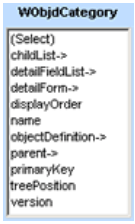Attributes
Each object in TeamConnect consists of multiple attributes, most of which appear in the object's main table in Object Navigator. For example, attributes for custom objects appear in the TProject table.

The following items can be displayed in Object Navigator:
- (End of Path) Attributes—Identify data end values and do not link to other tables. When selected, they are the end of the path.
For example, createdOn identifies the date a record was created. - Bridges—Bridges are items you use to traverse (navigate the relationships) between tables in the object model to build paths. You cannot use them as an end of a path.

Bridges always have an arrow (->) next to their name, and their names typically have the List suffix. For example, assigneeList-> links to the JProjAssignee table, which lists attributes about project assignees.
A bridge will only link to one other table. However, it is possible for multiple attributes to be bridges that link to the same table.
- Bridge Attributes—Bridge attributes are both attributes and bridges. Like bridges, they have an arrow (->) next to their name and can be used to traverse to another table. Because they also represent data, you can use bridge attributes to end a path.

For example, defaultCategory-> identifies an object's default category, but it also links to the WObjdCategory table, which contains attributes that represent specific information about the category.
For a complete list of TeamConnect attributes, including which attributes can be used to traverse tables, end paths, or both, see Object Model: Read This First.

